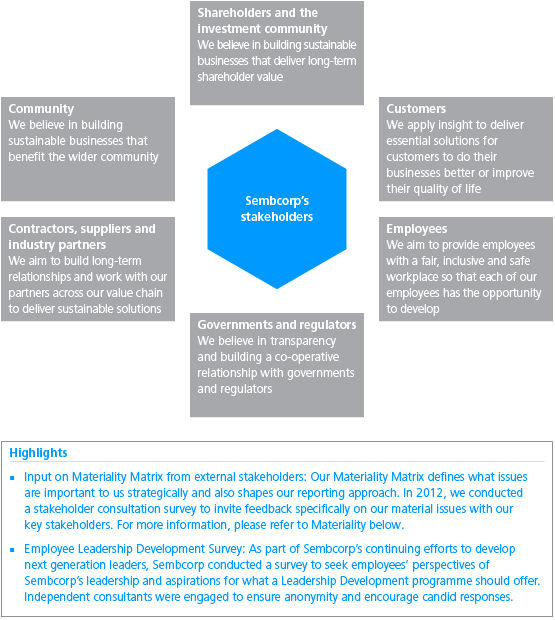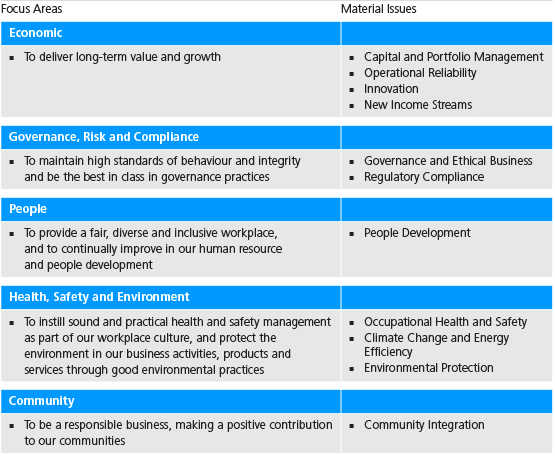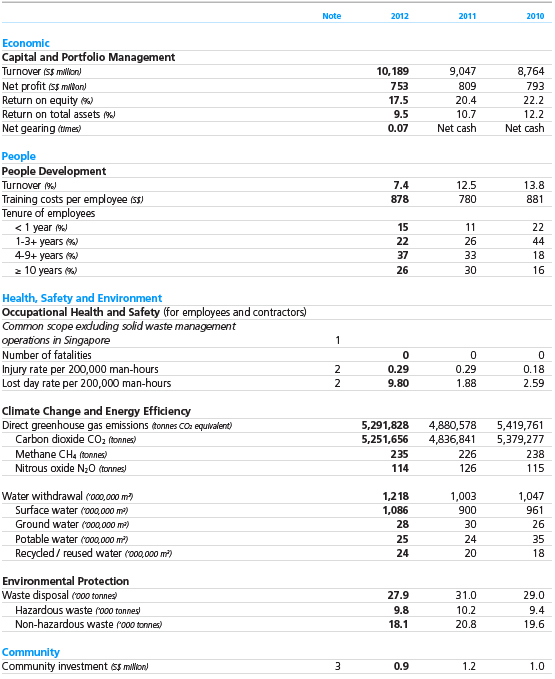|
|
|
 Email this page / Email this page /  Bookmark this page / Bookmark this page /  Download print-friendly PDF Download print-friendly PDF |

As an international enterprise and a public listed company, we understand that there is a complex value chain to which Sembcorp belongs and that our wider responsibility incorporates sustainability issues. This widening role of business is taken seriously and is reflected in Sembcorp’s commitment to excellence and continuous improvement.
The pillars of our sustainability principles are set out in our Sustainability Policy. Health, Safety and Environment (HSE) principles are specifically addressed in our HSE Policy. These principles are applied in the management systems and processes of Sembcorp’s operations, and monitoring of adherence and compliance with these systems are verified through plant audits. We continuously improve and expand the scope of sustainability management systems that we have in place, including corporate governance, risk management, health, safety and environment, human resource and community investment. Sembcorp also encourages the implementation of internationally recognised management systems across our operations, such as ISO 14001:2004 and OHSAS 18001:2007. We adopt a precautionary approach to avoid or minimise negative impacts through preventive measures and tracking of leading indicators.
To further strengthen our management of sustainability issues, Sembcorp’s Sustainability Steering Committee was established in late 2011 to review our sustainability roadmap and make strategic recommendations to improve sustainability performance across the organisation. The Committee, which consists of Sembcorp senior management, was chaired by Lau Gar Ning, Executive Vice President of Group Asset Management and Chief Health, Safety and Environment Officer. In January 2013, Mr Lau stepped down as Chairman of the Sustainability Steering Committee and our Group Chief Financial Officer, Koh Chiap Khiong, took over as the new Chairman. The Committee’s key findings and recommendations are presented to the Senior Management Committee.
We believe that membership and participation in external initiatives are also important platforms to facilitate and develop industry best practice. Kindly refer to the External Initiatives and Recognition section for details of our memberships and participation in industry initiatives.
Sembcorp welcomes feedback on our sustainability issues and reporting at [email protected].
At Sembcorp, we recognise the importance of engaging our stakeholders to encourage open communication and build relationships. We employ a range of platforms to engage our different stakeholders to develop mutually beneficial relationships. The frequency of our ongoing engagement with our stakeholders varies with needs of the stakeholders, as well as the platform and topics of engagement.
To further focus our stakeholder engagement efforts, we conducted a stakeholder mapping exercise in early 2012 to review and define our stakeholder groups. This was done in line with AA1000 Stakeholder Engagement Standard with the help of an independent consultant. Stakeholders were mapped based on their level of influence and interest, using a structured approach. Our key stakeholders are articulated below.

Information on our communication with the investment community including shareholders, analysts and potential investors can also be found in the Corporate Governance and Investor Relations sections of this annual report. Other examples of stakeholder engagement can be found here.
Materiality analysis is a key process in enabling Sembcorp to define the sustainability issues that are of greatest significance to our businesses and our stakeholders. It helps us review the relevance and risks of key issues for ourselves and our stakeholders, and focuses our efforts
in responding to those issues and opportunities.
This year, Sembcorp has adopted the progressive approach to report based on our 11 material issues, grouped into five focus areas. This is reflective of how Sembcorp is driving improvements on both the management approach and performance of the 11 material issues internally. Each focus area has appointed owners from senior management, who form the Sustainability Steering Committee.
Key material issues recognised by both internal and external stakeholders are illustrated in the table below. Sembcorp’s management approach and performance for these issues are elaborated in their respective sections.

Sembcorp conducted an internal materiality review with an independent consultant in 2011. The review involved identifying potential environment, health, safety, governance and social issues and prioritising them based on a Materiality Matrix approach, which charts their level of significance to Sembcorp and our stakeholders using clearly defined materiality criteria based on the AA1000AS five-part materiality process.
We continued to improve our materiality review this year, by inviting input from our key stakeholders, including shareholders, financial institutions, the investment community, regulators, customers, suppliers and non-governmental organisations. The survey was conducted by an independent consultant, to ensure anonymity for respondents. The respondents on a whole agreed with the material issues that were identified. The input helped to shape aspects of the material issues that our key stakeholders were interested in, and also how we could better communicate the issues.
The table below shows quantitative data that reflects our performance in areas which have been identified as material to our businesses and stakeholders. More performance data including qualitative data is available in the individual sections of each focus area as well as here.

Due to our expanded scope from 2010 through to 2012, we report trend data based on data that we have for all three years. The scope for trend data includes Utilities businesses for which Sembcorp has majority control as at December 31, 2012 in Singapore, China, the UAE and UK. This excludes the operations of Sembcorp Utilities (Netherlands), formerly known as Cascal, which were acquired in 2010. This scope provides at least 70% coverage of the parameters disclosed. For details on our scope for reporting, please refer to Our Approach to Reporting.
Notes:
| 1. |
Data from our solid waste management operations in Singapore is excluded from the common scope for more meaningful comparison and analysis, as the solid waste management business employs manual labour to a greater degree and has a different risk profile from other Utilities business operations. Safety data on our solid waste management operations can be found in the Health, Safety and Environment section. |
| 2. |
200,000 man-hours is roughly equivalent to hours worked by 100 full time employees in a calendar year. |
| 3. |
In 2012, we applied the London Benchmarking Group model to track and report our community investments. For more information, please click here. |
|
|
|
|